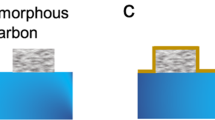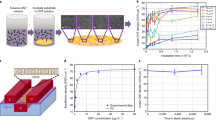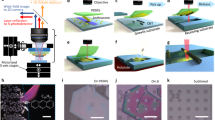Abstract
The potential applications of carbon nanotubes are varied1,2,3,4,5,6. Although it has long been known that solid carbon can reduce SiO2 to its gaseous state at high temperatures7, exploiting this reaction to pattern surfaces with carbon nanotubes has never been demonstrated. Here we show that carbon nanotubes can act as the carbon source to reduce (etch) silicon dioxide surfaces. By introducing small amounts of oxygen gas during the growth of single-walled carbon nanotubes (SWNTs) in the chemical vapour deposition (CVD) process, the nanotubes selectively etch one-dimensional nanotrenches in the SiO2. The shape, length and trajectory of the nanotrenches are fully guided by the SWNTs. These nanotrenches can also serve as a mask in the fabrication of sub-10-nm metal nanowires. Combined with alignment techniques, well-ordered nanotrenches can be made for various high-density electronic components in the nanoelectronics industry.
This is a preview of subscription content, access via your institution
Access options
Subscribe to this journal
Receive 12 print issues and online access
$259.00 per year
only $21.58 per issue
Buy this article
- Purchase on Springer Link
- Instant access to full article PDF
Prices may be subject to local taxes which are calculated during checkout




Similar content being viewed by others
References
Shim, M., Javey, A., Kam, N. W. S. & Dai, H. Polymer functionalization for air-stable n-type carbon nanotube field effect transistors. J. Am. Chem. Soc. 123, 11512–11513 (2001).
Javey, A., Guo, J., Wang, Q., Lundstrom, M. & Dai, H. Ballistic carbon nanotubes field effect transistors. Nature 424, 654–657 (2003).
Kong, J. et al. Nanotube molecular wires as chemical sensors. Science 287, 622–625 (2000).
Chen, R. J. et al. Carbon nanotubes as biocompatible materials and highly specific electronic biosensors. Proc. Natl Acad. Sci. USA 100, 4984–4989 (2003).
Besteman, K., Lee, J.-O., Wiertz, F. G. M., Heering, H. A. & Dekker, C. Enzyme-coated carbon nanotubes as single-molecule biosensors. Nano Lett. 3, 727–730 (2003).
Byon, H. R. & Choi, H. C. Network single-walled carbon nanotubes field effect transistors (SWNT-FETs) with increased Schottky contact area for highly sensitive biosensor applications. J. Am. Chem. Soc. 128, 2188–2189 (2006).
Koc, R. & Cattamanchi, S. V. Synthesis of beta silicon carbide powders using carbon coated fumed silica. J. Mater. Sci. 33, 2537–2549 (1998).
Choi, H. C. et al. Efficient formation of iron nanoparticle catalysts on silicon oxide by hydroxylamine for carbon nanotube synthesis and electronics. Nano Lett. 3, 157–161 (2003).
Snow, E. S., Juan, W. H., Pang, S. W. & Campbell, P. M. Si nanostructures fabricated by anodic oxidation with an atomic force microscope and etching with an electron cyclotron resonance source. Appl. Phys. Lett. 66, 1729–1731 (1995).
Li, J.-L. et al. Oxygen-driven unzipping of graphitic materials. Phys. Rev. Lett. 96, 1761011–1761014 (2006).
Ajayan, P. M. & Yakobson, B. I. Oxygen breaks into carbon world. Nature 441, 818–819 (2006).
Moulson, A. J. Reaction-bonded silicon nitride: its formation and properties. J. Mater. Sci. 14, 1017–1051 (1979).
Yao, Y., Falk, L. K. L., Morjan, R. E., Nerushev, O. A. & Campbell, E. E. B. Synthesis of carbon nanotube films by thermal CVD in the presence of supported catalyst particles. Part I: the silicon substrate/nanotubes film interface. J. Mater. Sci. 15, 533–543 (2004).
Homma, Y. et al. Role of transition metal catalysts in single-walled carbon nanotube growth in chemical vapor deposition. J. Phys. Chem. B 107, 12161–12164 (2003).
Li, Y. et al. Growth of single-walled carbon nanotubes from discrete catalytic nanoparticles of various sizes. J. Phys. Chem. B 105, 11424–11431 (2001).
Ural, A., Li, Y. & Dai, H. Electric-field-aligned growth of single-walled carbon nanotubes on surfaces. App. Phys. Lett. 81, 3464–3466 (2002).
Hong, B. H. et al. Quasi-continuous growth of ultralong carbon nanotubes arrays. J. Am. Chem. Soc. 127, 15336–15337 (2005).
Maruyama, S., Einarsson, E., Murakami, Y. & Edamura, T. Growth process of vertically aligned single-walled carbon nanotubes. Chem. Phys. Lett. 403, 320–323 (2005).
Acknowledgements
This work was supported by the Basic Research Program of the KOSEF (R01-2004-000-10210-0), the Nano/Bio Science & Technology Program of MOST (M10536090000-05N3609-00000), the SRC/ERC Program (R11-2000-070-070020), and the Korean Research Foundation (MOEHRD, KRF-2005-005-J13103). The authors thank J. M. Buriak, D. Karpuzov and Shihong Xu for the SEM, SAM and AES experiments. Moon-Ho Jo and Jee-Eun Yang are thanked for Cr metal evaporations, and Joon Won Park and Il Hong Kim for ellipsometer measurements.
Author information
Authors and Affiliations
Contributions
H.C.C. and H.R.B. conceived and designed the experiments. H.R.B. performed experiments. H.C.C. and H.R.B. co-wrote the paper.
Corresponding author
Ethics declarations
Competing interests
The authors declare no competing financial interests.
Supplementary information
Supplementary Information
Supplementary figures S1—S6 (PDF 1061 kb)
Rights and permissions
About this article
Cite this article
Byon, H., Choi, H. Carbon nanotube guided formation of silicon oxide nanotrenches. Nature Nanotech 2, 162–166 (2007). https://doi.org/10.1038/nnano.2007.26
Received:
Accepted:
Published:
Issue Date:
DOI: https://doi.org/10.1038/nnano.2007.26
This article is cited by
-
ZnSe nanotrenches: formation mechanism and its role as a 1D template
Nanoscale Research Letters (2011)
-
Crystallographically selective nanopatterning of graphene on SiO2
Nano Research (2010)
-
Nanofabrication: Groovy mechanisms
NPG Asia Materials (2008)
-
Nanotrenches Induced by Catalyst Particles on ZnSe Surfaces
Journal of Electronic Materials (2008)



